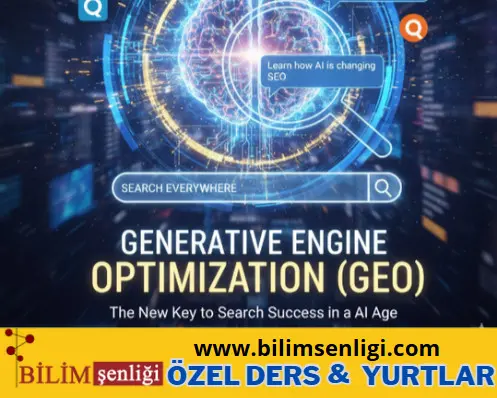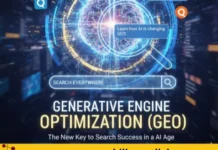
The internet world is in constant flux. In the early 2000s, the fundamental logic of search engines was to list the most relevant web pages for the keywords a user typed. Today, the era of simple listing is coming to an end. Artificial Intelligence (AI) and Large Language Models (LLMs) are fundamentally changing how users access information. At the heart of this revolution lies Generative Engine Optimization (GEO).
It is no longer enough for our content to merely appear among Google’s traditional 10 blue links; the main goal now is to be cited as a source in AI-supported summaries, specifically in the conversational language responses provided by tools like Google AI Overviews. GEO is precisely the set of strategies that ensures your brand survives and thrives in this new search era.
What is Generative Engine Optimization (GEO) and Why is it of Vital Importance?
Generative Engine Optimization (GEO) is the practice of creating and optimizing a brand’s content and digital presence to feature prominently in the summarized and conversation-based answers generated by AI-powered search engines and chatbots. While traditional SEO is focused on clicks and traffic, GEO is focused on citation and influence over the conversation.
A significant analysis predicts that LLM traffic will surpass traditional Google search by the end of 2027. This means that within just a few years, a large portion of users will discover brands not from traditional Search Engine Results Pages (SERPs), but directly from the summaries generated by AI. This period is referred to as the “Search Everywhere” era.
In this new paradigm, when a user enters a query, the AI generates an answer. This answer may or may not contain a direct link. If your brand fails to become a part of this generated response, it risks losing all visibility. Therefore, GEO plays a critical role in ensuring your content shapes the entire conversation, rather than just trying to gain a click.
The Cornerstones of GEO: How It Differs from Qualified SEO
The good news is that a successful Generative Engine Optimization (GEO) strategy is built upon a solid SEO foundation. Core SEO principles—such as producing high-quality content, ensuring technical accessibility, and gaining reliable references across the web—still play a role in determining which sources AI engines choose to reference.
However, AI engines do not operate exactly like Google’s traditional algorithm. This means that some tactics need to evolve.
- Technical Foundations and Readability for Bots
The first step of GEO is for your site to be technically flawless. Your content must be crawlable and indexable by AI tools. A technically robust website is:
- Fast and Mobile-Friendly: Slow-loading and non-mobile-friendly sites not only diminish user experience but also negatively affect the chances of being cited by AI systems.
- Secure (HTTPS): Security is a fundamental trust requirement for both users and AI systems.
- Prioritizes Server-Side Rendering (SSR): Given that some AI crawlers can still have issues with JavaScript, using SSR ensures smooth content accessibility.
- Demonstrating Trustworthiness and the E-E-A-T Principle
AI engines want to maintain the highest level of trustworthiness for the information they include in their responses. At this point, Google’s E-E-A-T (Experience, Expertise, Authoritativeness, Trust) principle is vital for GEO:
- Experience: Share your personal usage, firsthand knowledge, and actual results regarding the topic.
- Expertise: Stick to topics you genuinely know and produce in-depth, researched content.
- Authoritativeness: Become a recognized author in the industry, write guest posts, or get cited by reputable sites.
- Trust: Prove the reliability of your content by using real author bios, citing sources, and including references.
Advanced Strategies for Generative Engine Optimization (GEO)
For GEO success, more nuanced strategies that go beyond traditional SEO are required.
- Mentions and Co-Citations
While traditional SEO prioritizes backlinks, AI systems focus on co-citations. These systems pay attention to every mention of your brand across the web, even if it does not contain a clickable link. This demonstrates the immense value of brand awareness and positive reputation.
Action Plan: Audit existing mentions by searching for your brand name, products, and key team members on social media, industry forums, and within AI tools themselves. Analyze the emotional tone (positive, negative, neutral) of the AI’s discourse about your brand.
- Utilizing Multiple Platforms: Going Beyond Google
For Generative Engine Optimization, moving beyond Google is mandatory. Platforms containing User-Generated Content (UGC) like Reddit, YouTube, and Quora frequently appear in AI outputs. Establishing a strong and active presence on these platforms expands the pool from which AI draws data, helping you get cited more frequently.
- Understanding AI Citation Habits in Your Niche
The most effective way to understand what topics to target and how to create content is to learn how AI tools answer questions in your niche.
Action Plan: Go to tools like ChatGPT, Claude, or Perplexity and ask the questions your content aims to answer. Analyze which competitors are frequently mentioned, which platforms (YouTube, Reddit, etc.) are commonly cited as sources, and the sentiment of the mentions. This is a critical step that will directly shape your GEO strategy.
- Adapting Content to Conversational Queries and Structure
The way people search with AI tools differs from traditional keyword searches. Users are now employing longer, conversational, and question-based queries (e.g., “what should I cook for dinner if I’m trying to lose weight?”). GEO requires you to plan your content to answer these conversational queries.
Furthermore, the structure of your content must be optimized so AI systems can easily break it down and understand it:
- One Idea Per Paragraph: Keep paragraphs short and focus each one on a single main idea. Cramming multiple concepts into one paragraph makes it difficult for AI to extract the precise information it needs.
- Clear Headings and Subheadings: Organize your content logically with headings like H2 and H3. These act as signposts for both readers and LLMs.
- Break Down Complex Topics into Understandable Sections: When explaining complex processes, use numbered steps and clear transitions between sections. This makes it easier for AI systems to pull out a sequence of instructions step-by-step.
Conclusion: GEO is Adapting to the Digital Future
Generative Engine Optimization (GEO) is not a marketing fad; it is the future of the digital presence. While traditional SEO remains a fundamental cornerstone, in this new era where brands are chasing credibility and citation rather than just clicks, those who fail to implement GEO strategies will quickly fall behind the competition.
GEO is a holistic approach that requires content creators and marketers to understand not only the algorithm but also how AI is transforming the user experience. By making your content technically accessible, authoritative, multi-platform, and suitable for conversational language, you can ensure your brand remains a leading voice in the new search engine age. Generative Engine Optimization is the guarantee that your brand will not only exist today but will thrive and grow in the AI-powered world of tomorrow.






